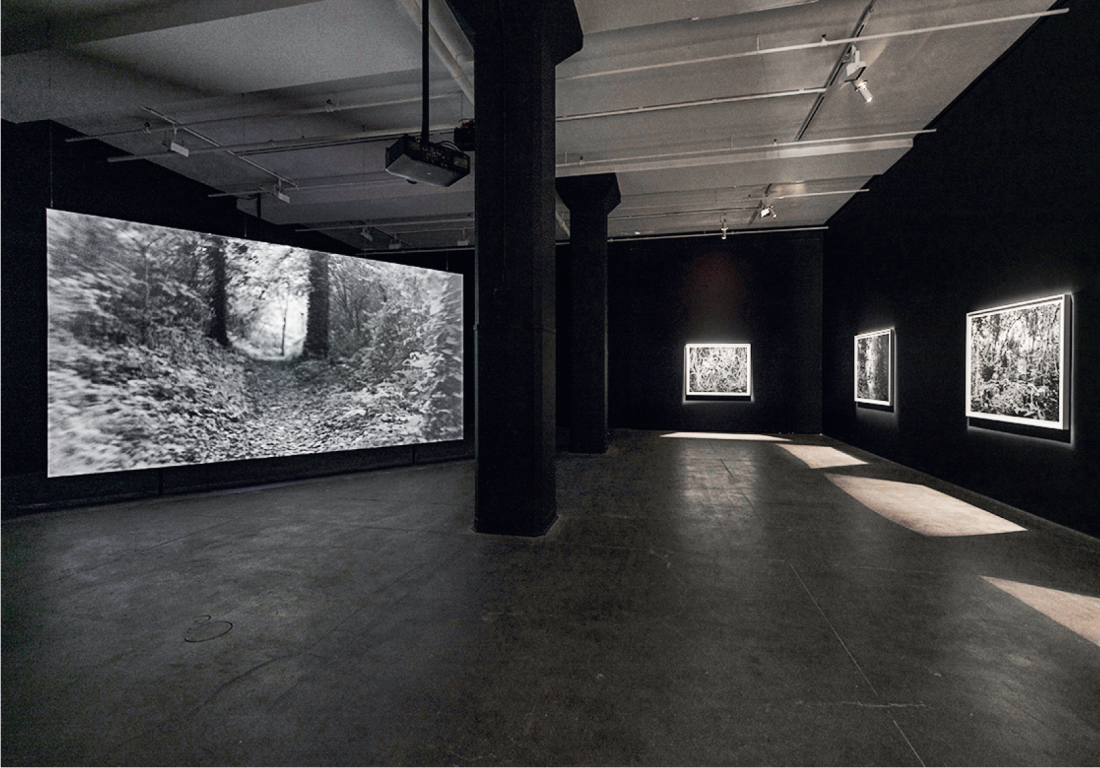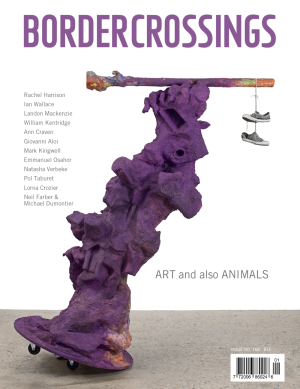Dawoud Bey
Horse hooves striking hard ground, metal against metal, wheezing and heaving, the unmelodious thrum of halting footfall on soft, wet earth—the soundscape of Dawoud Bey’s exhibition “Dawoud Bey: Stony the Road” creates an emotional tone before the visual objects can be approached. The lights are dimmed, and Bey’s large gelatin silver prints (13 in total) are spotlit against walls painted dark. The effect is dramatic and reverential. As one moves through the gallery, the stillness of the photographs is countered by the movement of Bey’s film 350,000, 2023, which seems to go on far longer than its roughly 10-minute run-time.
The film and the photographs depict an imagined journey along what’s known today as the Richmond Slave Trail. Historically, it was upon this path that African captives were marched into enslavement. Bey’s new body of work corresponds with two earlier landscape projects, “Night Coming Tenderly, Black,” 2017, which depicted real and imagined sites along the Underground Railroad, and “In This Here Place,” 2019, which focused on plantations in Louisiana. All three of Bey’s projects might be best contextualized through Bey’s phrase “ancestor work.” Beauty is always at stake in landscape photography; how beauty interacts with trauma is difficult to qualify, but it is what Bey’s photographs are capable of revealing.

Dawoud Bey, Untitled (Trail Through the Trees), 2023, gelatin silver print mounted to Dibond, 111.8 × 139.7 centimetres. © Dawoud Bey. Courtesy the artist and Sean Kelly, New York/Los Angeles.
Every picture in “Stony the Road” is either framing the path, which tends to bend from the camera, or looking away from it. Bey’s camera looks down toward the ground; it looks through vines and brambles; it looks outward over the James River—it does not look up. Neither is there much distance in Bey’s photographs; instead, everything is near. This is most extreme in Untitled (Tangled Branches), 2023, wherein a great mass of ropy vines occupies the entire picture plane. A cluster of dry leaves remains on the vine, curling inwards. Bey captures them as a gentle light illuminates their crisp forms, accentuating a feeling of tenderness and fragility.
The absence of distance in Bey’s pictures does not make them intimate; the density of the landscape prohibits a view of anything but what is close by. Consequentially, it’s hard to orient oneself. This sense of disorientation is a profound aspect of what Bey’s photographs are doing. A landscape in which one loses orientation is a landscape in which one becomes detached from a sense of place—a placeless landscape. The narrative quality of Bey’s film reinforces the feeling of being lost. The camera pans this way and that, as if searching for something it can’t find. To use the camera as a way of inhabiting the presence of those who are no longer present may be the crux of what Bey means when he talks about doing “ancestor work.”
How a place makes meaning and how that meaning can be transmitted through a photograph are perennial questions for landscape photographers. Great photographers are always finding new ways to respond, but the basic formula has to do with memory and emotional response, and how those twining qualities affect one another. The act of preserving the path retains the events that brought it into being. In Untitled (Crooked Trees), 2023, a stick lays across the path. It is not the subject, which is more likely the trees that appear weighed down by the climbing vines that cover them. The stick could have been removed easily by the photographer. Instead, he chose to keep it, and in a composition dominated by the verticality of tree trunks, the little stick sticks out. The small choice feels huge. It disrupts one’s visual journey down the path, and in the pause created by that stick the entire picture seems to pivot.

Dawoud Bey, installation view, “Stony the Road,” 2025, Sean Kelly Gallery, New York. Photo: Adam Reich. Courtesy the artist and Sean Kelly, New York/ Los Angeles.
Bey did not choose to photograph the Richmond Slave Trail on his own. He was invited by curator Valerie Cassel Oliver to make the work for an exhibition at the Virginia Museum of Fine Arts in 2023. In a metaphorical sense, the place called to the photographer—through Oliver’s invitation—and in accepting the commission the photographer responded. This is not insignificant, because a photographer’s relationship to the environment in which they make their art shapes every other aspect of the image. This is not always something you can see; often it’s a quality you can only feel. There are passages in some pictures where the light coming through the canopy reflects off the James River and for a moment it is as if sunshine is everywhere, penetrating the forest from all sides. For a moment the density of the forest is uplifted, and in that brief passage the photograph feels sublime.
The title of Bey’s film, 350,000, is an estimate of the number of people forced to walk this path, to look out over this river. By comparison, fewer people live in the city of Newark. For all the dizzying movement and blur of the film, it is a singlechannel piece and therefore evokes a singular experience of the path. On a one-to-one scale, empathy comes quickly, and on the heels of that connection comes the feeling that these images are all haunted insofar as they establish presence and give a sense of body to those who are without body. It seems counterintuitive for a visual medium to endeavour to show that which cannot be seen. Yet, this is what Bey has set out to do; it is what he has achieved—a spectre of the past made alive in the present. ❚
“Dawoud Bey: Stony the Road” was exhibited at Sean Kelly Gallery, New York, from January 10, 2025, to February 22, 2025.
Charles M Schultz is a writer based in New York City. He is the managing editor for the Brooklyn Rail.

